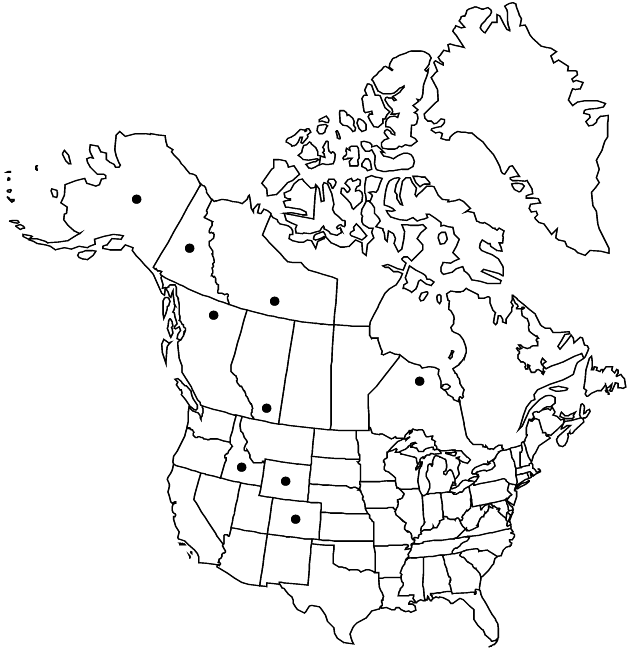Aster alpinus subsp. vierhapperi
Biblioth. Bot. 26(106): 25. 1932.
Plants 2.5–32 (–40) cm, cespitose; rhizomes woody, caudices thick, woody, branched, ± covered with marcescent leaf-bases. Stems 1 (per rosette), erect to ascending, simple, ± densely white-villous, becoming nearly woolly near heads, sometimes short-stipitate-glandular proximally, ± densely short or long-stipitate-glandular distally. Leaves basal and cauline, margins entire, densely villous-ciliate, faces ± densely villous, ± densely short-stipitate-glandular or (distal mainly) eglandular; basal persistent, usually petiolate to subpetiolate, sometimes sessile, blades 3-nerved, oblanceolate or obovate to spatulate, 10–112 × 2.5–14 mm, bases cuneate or attenuate, apices ± acute to rounded; cauline usually sessile, lanceolate or lance-oblong to linear-lanceolate or linear, 7–43 (–50) × 1–6 (–8) mm. Heads borne singly. Involucres broadly hemispheric, 6–11 mm. Phyllaries in 2–3 series (usually green, sometimes ± purplish), lanceolate to lance-oblong, subequal, herbaceous, apices acute (outer) to acuminate or ± cuspidate (inner), faces ± densely villous, sometimes ± sparsely short-stipitate-glandular. Ray-florets (20–) 25–55 (–95); laminae pink, white, or lavender [purple], (9–) 11–17+ × (1–) 1.6–2.4 mm. Disc-florets 50–100+; corollas yellow turning brown, 5–6 mm, tubes much shorter than funnelform throats. Cypselae tan to brown or dark reddish-brown, obovoid, compressed, (2–) 2.5–3.2 mm, 2 marginal ribs plus 0–2 thin nerves on each face, faces ± densely strigillose, sometimes gland-dotted; pappi tawny to white, 5–6 mm, about equaling disc corollas. 2n = 18.
Phenology: Flowering early summer.
Habitat: Open to semishaded, mesic to dry, rocky, gravelly or silty, often calcareous areas, alpine tundra, montane to alpine meadows, cold prairies, Artemisia steppes, gravelly or eroding stream banks and flats, edges of open riparian boreal forests, bluffs, talus and cliffs, sandy ridges in muskeg
Elevation: 10–3700 m
Distribution

Alta., B.C., N.W.T., Ont., Yukon, Alaska, Colo., Idaho, Wyo., e Asia (Russian Far East), e Asia (e Siberia)
Discussion
Aster alpinus is the only species of the genus in the strict sense that is native to North America. The report of the species for Quebec on the NatureServe website is erroneous. The species is thought to be rare in Ontario, Colorado, Idaho, and Wyoming. The reports for Idaho and Wyoming are new. Confusion in identification often occurs with Erigeron caespitosus Nuttall, E. glacialis Nuttall, and E. hyperboreus, among others. J. C. Semple et al. (2002) used the name A. culminis for the North American entity; my study of Russian and North American material showed that it is not possible to distinguish between Siberian and North American materials, which indeed share a pubescence type different from that of the typical subspecies. It is not possible to divide the species easily into distinct species or varieties. The only difference found in material from the two areas is that rays in the former tend to be purple, while in the latter they are mostly pinkish white to pink, sometimes purple, a difference deemed insufficient at the present time to warrant species recognition. A thorough biosystematic and molecular study of the complex may resolve this taxonomic problem.
Aster americanus Onno, referable here, is an invalid name.
Selected References
None.
Lower Taxa
"thin" is not a number.